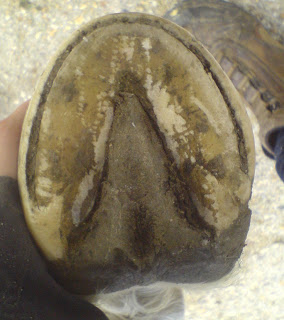 |
| Aug 10 - slightly contracted - note lack of substance and the groove between bulbs |
 |
| Aug 10 solar view of above - note weak butresses and deep central sulcus |
 |
| Oct 10 - heels decontracted - note how groove has disappeared |
 |
| Oct 10 solar view of above - note changes to buttresses, central sulcus, sole and frog generally |
 |
| Note weight bearing section of heel is towards middle of foot Note weak structure, poor horn quality, excessive wall rasping |
 |
| Slowly weight bearing section moving back to where it should be - toe still really long, quality improving a little |
 |
| Heel in suspension, lami rings, excessive wall rasping |
 |
| Contracted, infected, sore and weak |
 |
| Few weeks later, decontracting, infection cleared, not sore |
 |
| later still, note heel bulb position and shape |
Of all the structures most abused in the horses hoof, my current bug bear is heels. Remember 'Fred'? Tall heels, contracted heels, infected heels and underrun heels. None of these are normal or healthy and with appropriate care, diet and exercise they can all be improved. A good heel is vital to a horse and sentiment aside, a horse with a well formed hoof is going to stay sound longer.
Oh and for those debating shoes/boots - if you need to put something on your horse's foot, boot everytime. I have yet to deshoe a horse that had a good heel, but they can usually grow/build one pretty quick once that shoe gets taken off.
NB - building good heels doesn't happen by magic or overnight - a good diet and an appropriate management regime are important. And even horses living in less than ideal conditions can have a good foot/heel if they work hard enough








2 comments:
sooo when you say correct working regime what would you suggest is done?
Walking on varied surfaces? :o)
Appropriate management regime...... Deliberately broad term because the specifics vary although the aims are the same.
Heels need to be engaged - ie contact the ground, to work, to be properly trimmed (not left to grow to sky scraper proportions, nor cut to the quick. To be kept infection free.
A variety of surfaces of best - but they must be suitable for the current state of health. Soft arenas won't build strong feet, but they might be all a sick foot can cope with in the early stages of rehab.
Speed etc should be what the horse can deal with at the time. My girl has to trot some of the time, but weak horses/heels won't cope until they are stronger.
Post a Comment